The Ultimate Guide to B2B Email Marketing Lead Generation
Your business success hinges on various factors, with building a broad network being a key one. Achieving this extensive reach is possible without even leaving your desk. B2B email marketing is a powerful tool for generating leads and connecting with potential clients.
We have put a lot of effort into creating this complete guide to B2B email marketing, including examples and best practices. By the end of this article, you'll know what B2B email marketing is, why it is important, how to build your own B2B email marketing campaign, and have some idea on how to start.
What is B2B Email Marketing?
B2B email marketing is done by one business (the sender) to another business (the recipient). Typically, it is conducted by companies looking to sell products or services to other businesses, like software solutions, office supplies, or consulting services.
Why do people use B2B email marketing?
- Build relationships with potential and current business clients.
- Generate leads and convert them into sales.
- Educate the target audience about products or services.
- Retain clients through updates, offers, and consistent value.
One of the well-known examples of B2B email marketing is Udemy's "Udemy for Business" campaigns. These emails are designed to address company needs, showing how businesses utilize their affordable solution for employee development.
Another example is LinkedIn, which uses B2B email marketing to promote its business solutions, such as LinkedIn Ads, Sales Navigator, and Learning Hub.
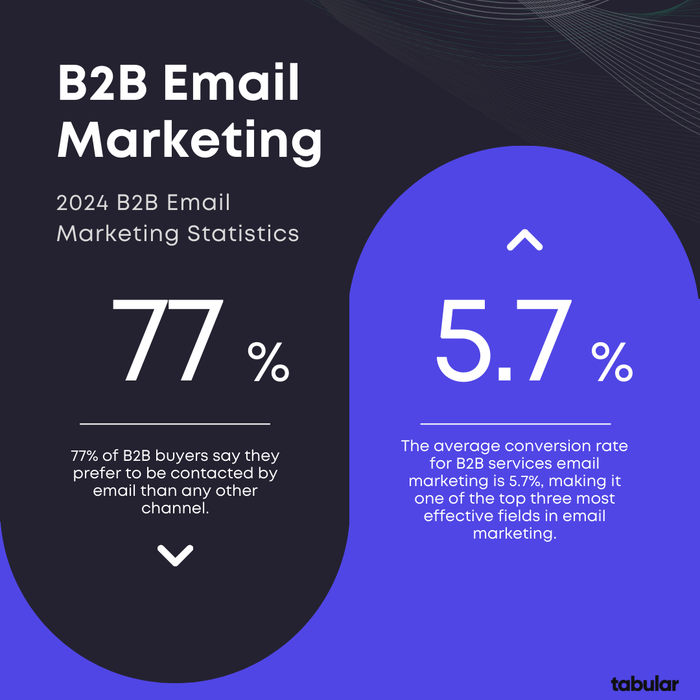
Business-to-business (B2B) email marketing involves using email campaigns to promote products, services, or content from one business to another. These campaigns can help you build professional relationships, generate leads, and drive sales within your business.
According to ExploringTopics.com, 76% of companies use marketing automation. B2B email marketing templates make this system work. With B2B email templates, you can save time, maintain brand consistency, and easily allow for personalization.
B2B email marketing builds long-term business relationships, while B2C targets quick sales. LinkedIn’s emails promote tools like Sales Navigator for lead nurturing, whereas Spotify's B2C emails focus on personalizing offers and encouraging immediate subscriptions.
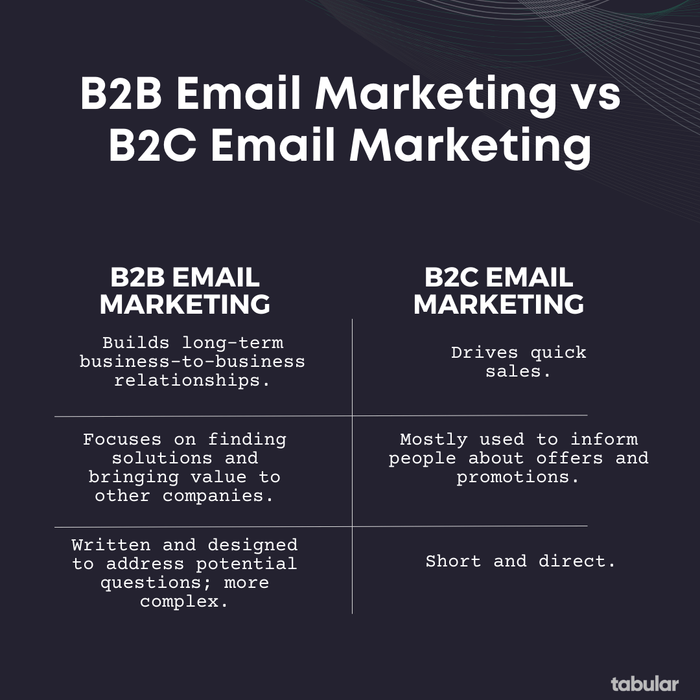
Why B2B Strategies Require a Different Approach
In our previous blogs, we've discussed various email marketing strategies, including Business-to-Consumer (B2C). You might wonder why there’s a need for a distinct approach when it comes to B2B email marketing funnel strategies. The key reason is that aiming higher can lead to greater revenues.
In B2B email campaigns, you're not just promoting products; you're conveying your entire brand identity to another business owner, who is likely familiar with your strategies for consumers. This makes it crucial to design your emails thoughtfully and clearly articulate your goals. Unlike B2C, B2B has a longer sales cycle, often involving multiple decision-makers in the process. Reaching and converting these decision-makers requires targeted messaging that emphasizes the immediate benefits of partnering with your company. As a result, you're engaging with a more knowledgeable audience within your industry, dealing with longer sales cycles, and needing to craft your content with greater precision.
But don't let these challenges overwhelm you. We'll guide you through setting up your strategy step by step, ensuring you’re equipped to succeed in B2B email marketing.
10 Key Strategies for B2B Email Marketing Lead Generation
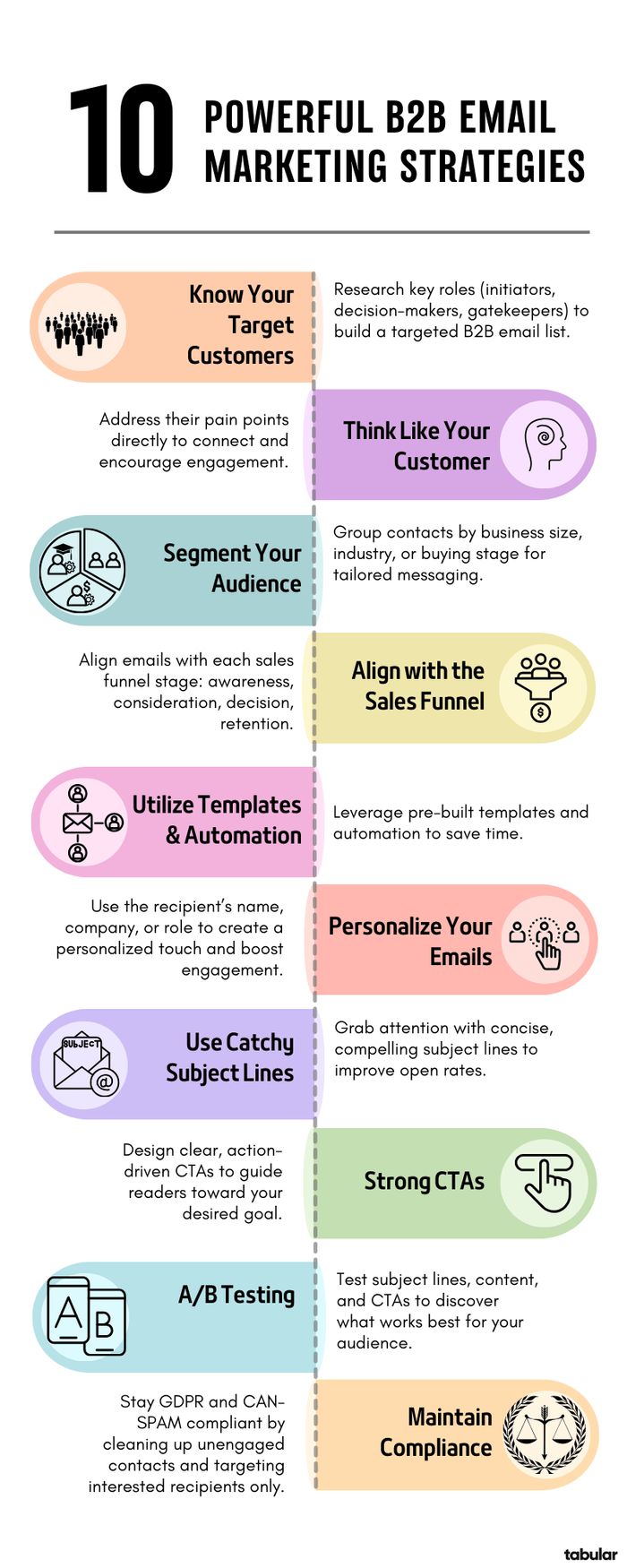
1. Know Your Target Customers
To start, it's crucial to research your audience so you can craft a relevant and engaging B2B email marketing templates.
To capture their attention, you first need to understand who you're reaching out to. You can conduct your research by focusing on specific roles within a company, such as initiators, decision-makers, or gatekeepers.
This allows you to segment your audience by business and create a targeted B2B email list.
2. Think Like Your Customer
Once you've identified your target audience and established a baseline persona, it's important to empathize with them.
For successful email marketing B2B lead generation, you need to think like your persona. By directly addressing your audience's pain points, you demonstrate that you understand their specific needs.
This makes them more likely to engage with your email or consider doing business with you. As you can see, research plays a critical role throughout the entire process of designing your email templates.
3. Audience Segmentation
Consider a scenario where you're selling your product door-to-door locally. You'd have to tailor your pitch to meet each potential buyer's needs. Similarly, when developing your B2B email marketing funnel strategy, audience segmentation is key.
You can segment your audience based on factors like business size, industry, or buying stage to ensure your messaging is targeted. Once you've created your basic templates, this process will become more streamlined.
4. Stage Your Campaigns
Using a customer journey map for each step of your campaign is essential if you want your business to succeed.
This approach also allows you to easily revisit previous stages of the journey as needed.
You should create B2B email marketing examples for each stage of the customer journey; awareness, consideration, decision-making, and retention.
5. Templates & Automation
Even though designing email templates and sending them consistently might seem daunting, it's a task that will boost your revenue. To simplify this process, you can use pre-built templates from Tabular's designer email templates. By crafting professional-looking email templates, you can leverage automation to schedule your emails, eliminating the need for manual effort.
6. Personalization
We've already discussed the importance of segmented audiences and how they can yield positive results.
You can take this a step further by using personalization to address your audience's needs individually. Mentioning the recipient's company name, title, role, or specific pain points can help you connect with them directly. This approach will aid in building a strong and lasting relationship with your customers.
With Tabular.email's template builder, you can customize and build personalized, responsive HTML email templates that perform effectively.
7. Subject Lines
The open rates of your emails depend largely on three factors: the sender's address, the subject line, and the opening line. When crafting the body of your email, it's important to also focus on creating an attention-grabbing subject line. For tips on writing the perfect subject line, you can visit our blog.

8. CTAs
The ultimate goal of your B2B email marketing strategy is to guide your readers toward taking action—whether that’s visiting your website, downloading your digital product, or making a purchase.
Therefore, creating a high-conversion CTA is crucial. Use eye-catching colors, compelling slogans, or even animations to draw attention to your CTA.
9. A/B Testing
To ensure your B2B sales email templates remain effective, it's important to update them regularly and determine which versions work best.
A/B testing allows you to send different email templates to various focus groups, helping you evaluate metrics and statistics for subject lines, content, and CTAs to improve performance.
Create your template using our email template builder.
10. Compliance
Finally, make sure that your emails reach only those who are genuinely interested in hearing from your business.
Maintaining high open and click-through rates is vital, so it's important to remove unengaged contacts from your B2B email lists.
This practice will help prevent your emails from landing in spam folders, keeping your campaigns effective and compliant.
B2B Marketing Funnel: From Awareness to Retention
B2B email marketing funnel strategies are designed to map out the different stages a customer navigates before making a purchasing decision. Essentially, this is a strategically crafted customer journey that aims to maximize your benefits. By focusing on the four key stages—awareness, consideration, decision-making, and retention—you can effectively guide your customers through the funnel, increasing the likelihood of converting them into potential buyers.
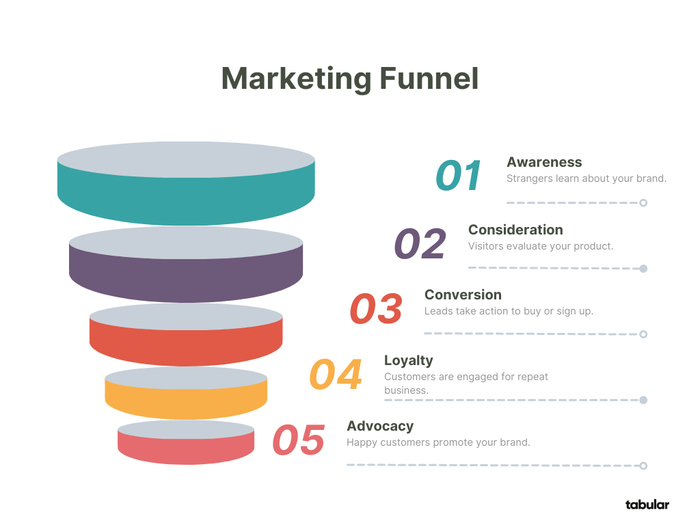
Awareness Stage
At the Awareness Stage, your primary goal is to introduce your brand and make potential customers aware of your business. This involves familiarizing them with your services or products without any direct sales pressure. Use educational content such as blog posts, eBooks, and industry insights to engage your audience. By offering valuable information, you position your company as a thought leader and build initial recognition within your industry.
Consideration Stage
In the Consideration Stage, the focus shifts to building trust and establishing long-lasting customer relationships. Demonstrate the value of your product through case studies, customer testimonials, product demonstrations, and comparisons. Highlight the benefits of your product or service, showcasing your credibility and reliability with real-world examples and success stories. This evidence of success helps to convince potential customers of the value you offer and encourages them to consider working with you.
Decision-Making Stage
The Decision-Making Stage is where you aim to enhance email marketing B2B lead generation. Capture your recipients' attention with special offers, free trials, pricing details, and ROI calculations. Use urgent-sounding B2B email marketing examples to create a sense of urgency and motivate leads to make a purchase decision. This stage is crucial for converting leads into customers.
Retention Stage
In the Retention Stage, the focus shifts to maintaining engagement with existing customers. Even after a purchase, continue to provide value through tutorials, product updates, and renewal offers. This strategy involves sending follow-up emails that offer product training, usage tips, and exclusive offers to existing customers. By doing so, you enhance customer loyalty and foster long-term satisfaction.
Successful B2B Email Marketing Examples
Success stories are not just important for your customers—they can also be highly beneficial for you. By studying and applying successful B2B email marketing best practices, you can craft compelling email campaigns. Let’s explore how companies like UXPin, Grammarly, Webflow, and Semrush have effectively implemented these strategies.

UXPin exemplifies a strong approach with its "What’s new" newsletter segment. This section updates customers on product developments, interesting articles, and virtual events.
UXPin’s straightforward design, fanzine-style icons, and concise copywriting create an easy-to-read format that keeps its audience informed about its services and products.
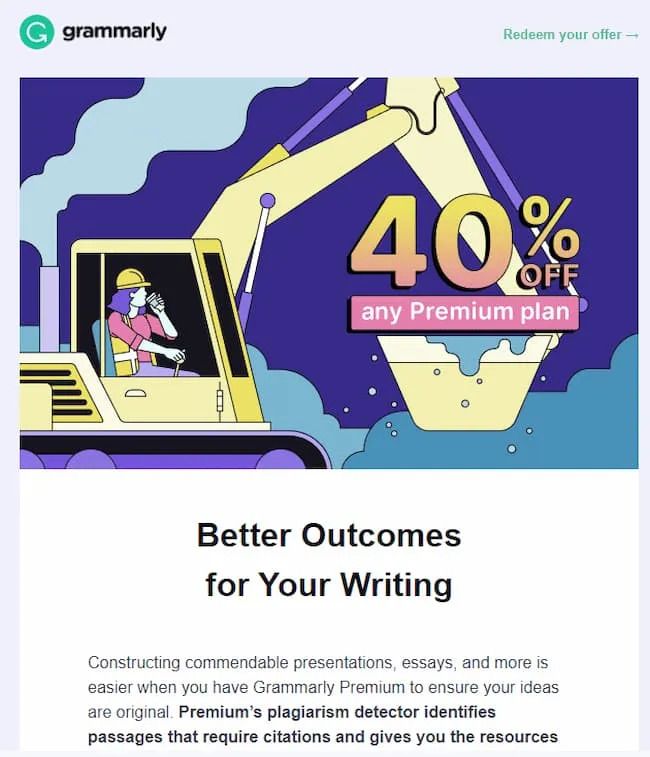
Grammarly uses a compelling B2B lead generation strategy by offering a 40% discount on their Premium plan. The urgency of this offer is emphasized with a bold visual in the email's hero area, along with attention-grabbing CTAs. This design choice significantly impacts the decision-making process, driving recipients to act quickly on the special offer that aligns well with their needs.

Webflow captures attention through its vibrant design and engaging language. They use a Woodstock-style font to promote a series of online events, branding it as the "Virtual World Tour." The campaign highlights its scope with "3 weeks, 12 events, 9 time zones," effectively showcasing the event's scale and creating excitement among recipients.
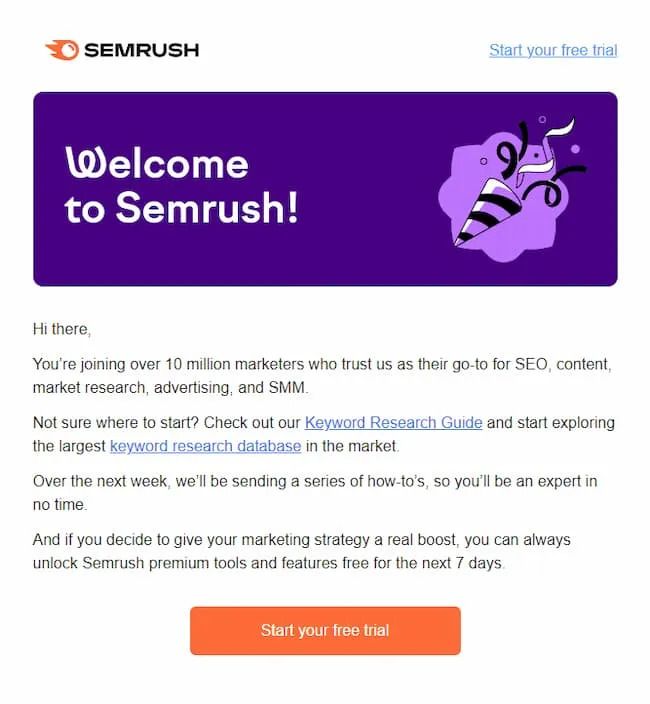
Semrush focuses on the B2B lead generation model by reaching out to new subscribers early in their customer journey. Rather than pushing for an immediate sale, Semrush takes a more subtle approach, providing clear information supported by statistical data and effective design. Staying current with trends also plays a key role in their strategy, enhancing their engagement with new leads.
B2B Email Marketing Tips
In the earlier sections, we explored the fundamentals of B2B email marketing, from understanding the difference between B2B and B2C strategies to creating compelling templates and optimizing your marketing funnel.
Now, it's time to take a step further with actionable, detailed tips to elevate your B2B email marketing campaigns.
You'll also discover how to effectively manage your data, nurture leads, monitor key metrics, and refine your email design for better engagement.
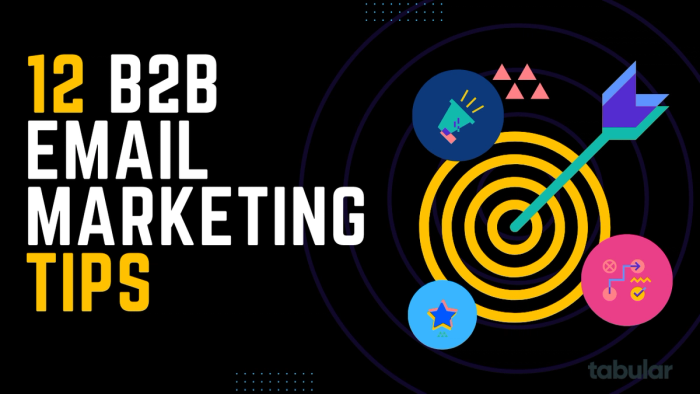
Build Strong Relationships Through B2B Email Marketing Campaigns
Who doesn’t want to say hi to leave a good impression? Welcome emails serve that purpose in the email marketing world, and they are extremely important.
You can use an email marketing platform like Mailchimp to create sequences and Tabular.email to design responsive, high-performing HTML welcome email templates.
Consistent Communication: Regularly send out newsletters and updates that address your subscribers’ needs, industry trends, and relevant news. It’s important to build trust through ongoing, meaningful communication.
Personalized Content: Address recipients by their name, and consider their industry and challenges. Customize your messages to help them solve specific pain points, this will increase credibility and customer loyalty.
Social Proofs are Crucial for Lead Generation
Include Case Studies & Testimonials: Use email content to showcase how your product or service has benefited other customers. Highlight quotes, reviews, or detailed case studies to enhance authenticity and trust.
You can also embed customer reviews from platforms like G2 or Trustpilot for added credibility.
Create High-Quality Content in Your HTML Email Templates
Understand Buyer Intent: Create content that aligns with the needs and pain points of your target audience. Use informative resources, actionable tips, and business-specific examples to engage your readers
Effective CTAs: Each email has to have a clear Call-To-Action (CTA). Whether it’s to download a resource, register for a webinar, or contact your team, make the next step obvious.
Subject Line Optimization: Write compelling subject lines that grab attention and hint at the content's value, without being overly salesy.
Use Tabular.email to design engaging and responsive email templates, including strong CTAs and appealing visuals.
Create your template using our email template builder.
You can also incorporate personalized elements easily within your templates to resonate with your target audience and drive engagement.
Manage Your Data and Be Efficient
Clean & Segment Your List: Regularly remove outdated leads and maintain accurate data. Segment your list by buyer persona, industry, job function, or seniority to send targeted and relevant messages.
Utilize Klaviyo to create segments based on industry, job role, or past purchases. For example, if you have a segment for “C-Level Executives,” your messaging should focus on high-level benefits and ROI.
Don’t Forget Lead Nurturing
Create Lead Nurturing Sequences: Develop a series of emails for different stages of the sales funnel: Awareness (introducing your solution), Consideration (providing resources and comparisons), and Decision (showcasing customer stories or promotions).
Leverage Sales Triggers & Scoring: Use lead-scoring tools to identify prospects ready for engagement. Send targeted, high-value content to these leads to nurture them towards a purchase decision.
Map out sequences for different buyer journey stages. Use HubSpot’s Workflows to automatically send emails based on triggers like when a lead signs up for a webinar (awareness stage) or requests a product demo (consideration stage).
Track Your Metrics to Optimize Your B2B Email Marketing Campaign
Utilize Google Analytics with UTM parameters in your email links to see where users go on your site after clicking an email. Alternatively, use built-in analytics in Mailchimp or ActiveCampaign to monitor open rates, click-throughs, and conversions.
A/B Test Subject Lines & CTAs: Experiment with different subject lines, send times, and CTAs to understand what resonates most with your audience. Use the data to refine future campaigns.
Use Mailchimp’s A/B Testing Feature to test different email elements such as subject lines, content, and send times. Review results and choose the best-performing option for future campaigns.
Optimize Email Design
Make sure that your email templates look good on any device. Test your email’s appearance across different email clients and devices.
Keep image sizes small to reduce load times and ensure emails load quickly.
Tabular.email's drag-and-drop email builder offers free designer email templates for you to choose from. Every email template built with Tabular works seamlessly across all major email service providers.
Directly Target Individuals with Personalization
Align your content with different personas or industries to make it feel more relevant to each recipient.
Use dynamic content blocks. Tabular.email allows you to insert dynamic content based on user behavior. For instance, if someone has shown interest in a particular service, automatically showcase related offers or content in future emails or just call them by their name.
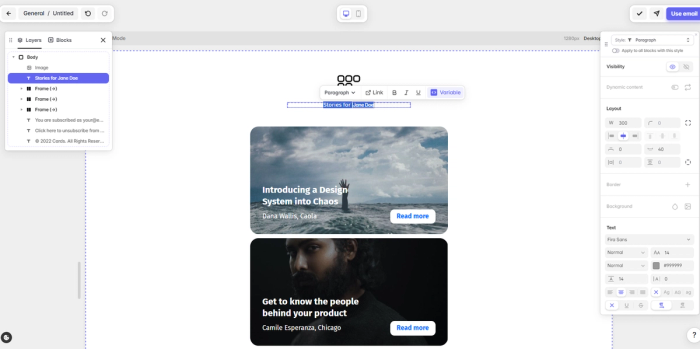
Segment Your Customers
Segment by Criteria: Group your email list based on company size, geographic location, industry, interests, and job title. This helps to send more targeted campaigns that address specific needs.
Use Mailchimp create segments based on customer behavior, such as “new subscribers,” “repeat customers,” or “high-spending clients.” Customize content specifically for each segment to improve relevance and engagement.
Integrate your CRM with email marketing software to automate list segmentation based on the buyer’s journey, location, and industry.
Choose the Right Time to Send Your Emails
Use platforms like Omnisend to find out the optimal time to send emails to your audience by analyzing open and click behavior.
Consider experimenting with different days and times for better results.
For subscribers across different time zones, schedule your emails to be sent at a local hour convenient to them using tools like Mailchimp’s Time Zone Send.
How Should the Technical Setup Be for B2B Email Marketing?
Ensure Deliverability: Make sure your email campaigns comply with spam regulations and use verified email addresses. Monitor your IP and domain reputation to prevent emails from being marked as spam.
Use tools like MailWarm to gradually warm up your IP address if you’re starting from scratch. This improves your reputation with ISPs and helps your emails avoid spam folders.
Make sure your domain is properly authenticated with DKIM and SPF records by working with your email marketing platform’s support team.
Consider Automation
Use automation tools that integrate with your CRM to create automated workflows, nurturing leads based on behavior and data.
Implement automated, triggered email journeys based on user actions, such as website visits, email clicks, or form submissions. Personalize content to guide leads effectively through the sales funnel.
Conclusion
In this blog post, we've explored the essentials of B2B email marketing, including its benefits for creating long lasting relationships, connecting with large businesses, and leveraging your network.
By implementing a carefully planned approach by setting precise goals, segmenting your audience, and building trusting relationships, you can effectively use B2B email campaigns to your advantage.
By following the customer journey through various stages, from awareness to retention, you can optimize your B2B email marketing funnel strategies.
Consistently crafting thoughtful and well-targeted email templates will significantly impact your recipients and enhance your business outcomes. We hope this article has provided valuable insights and that you’re now ready to create your own effective B2B email marketing templates!